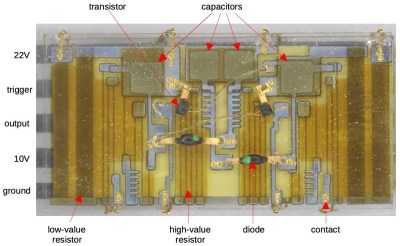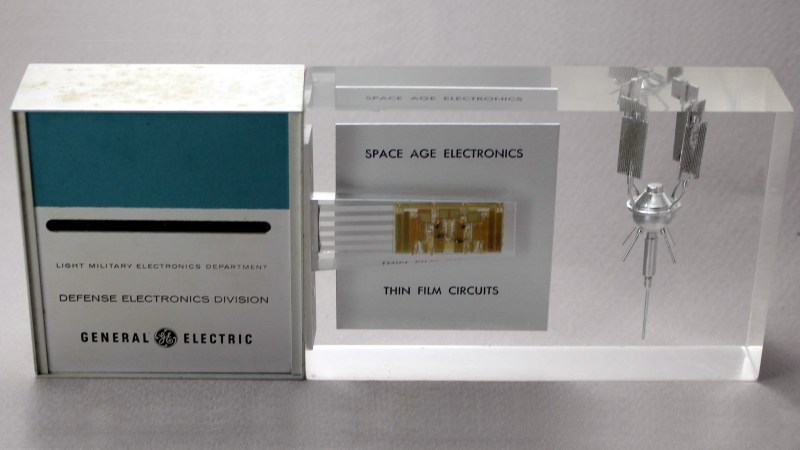[Ken Shirriff]’s analysis of a fascinating high-tech paperweight created by GE at the height of the space race is as informative as it is fun to look at. This device was created to show off GE’s thin-film electronics technology, and while it’s attractive enough on its own, there’s an added feature: as soon as the paperweight is picked up, it begins emitting a satellite-like rhythmic beep. It is very well-made, and was doubtlessly an impressive novelty for its time. As usual, [Ken] dives into what exactly makes it tick, and shares important history along the way.

Thin-film electronics reduced the need for individual components by depositing material onto a substrate to form things like resistors and capacitors. The resulting weight and space savings could be considerable, and close-ups of the thin film module sure look like a precursor to integrated circuits. The inside of the left compartment contains a tilt switch, a battery, a vintage earphone acting as a small speaker, and a small block of components connected to the thin-film module. This block contains two oscillators made with unijunction transistors (UJTs); one to create the beep, and one to control each beep’s duration. The construction and overall design of the device is easily recognizable, although some of the parts are now obsolete.
If you’d like a bit more detail on exactly how this device worked, including circuit diagrams and historical context, be sure to click that first link, and pay attention to the notes and references at the end. One other thing that’s clear is that functional electronics embedded in clear plastic shapes simply never go out of style.
















Circuits and/or systems somewhat like the macro-structure of the encapsulated 1960’s example are still in wide use today and in most cases considered to be high-technology. For example: Low and High Temperature Co-Fired Ceramic devices (LTCC, HTCC)[1], Monolithic Microwave Integrated Circuit devices (MMIC)[2], and Micro-Electromechanical Systems (MEMS)[3], to name just a few.
* References:
1. Co-fired ceramic
https://en.wikipedia.org/wiki/Co-fired_ceramic
2. Monolithic microwave integrated circuit
https://en.wikipedia.org/wiki/Monolithic_microwave_integrated_circuit
3. Microelectromechanical systems
https://en.wikipedia.org/wiki/Microelectromechanical_systems
Could have used two 555’s (joke), they didn’t exist yet though.
Careful, don’t scratch that film.
This would be cool inside a clear cube and a little plaque describing the chip. Maybe labels inside near each module.
Ironically, the first integrated circuits (ICs) were installed in electron tubes (transparent/clear chassis).. :)
https://en.wikipedia.org/wiki/Loewe_3NF
Its quite a slick looking piece of deskwear. Looks like something from Space Odyssey.
And that font. Yum. That font.
Was this Thin-film technology immune from the effects of photons ?
( I’m thinking about this https://hackaday.com/2015/02/08/photonic-reset-of-the-raspberry-pi-2/ where laser pointers or xenon flashes would cause a hard reset )
Nevermind just read the linked article and all the semiconductor components have black blobs around them to block out the light.
I have a lucite paperweight with 2 early IC’s, magnetic core memory piece and a R/W head from a harddisk drive (12 in platter). It’s from NCR as a promotional piece for its 1968 release of the NCR Century 100 and 101 mainframe. You can see what it looks like here. https://www.ebay.com/itm/124594692385. (hope its okay to post this link)
Mine is a US version and not worth much. Tbe one in the article is far more cooler than mine.
Enjoyed your article about the GE thin film paperweight from the 60’s space era. Cool that it actually has electronics built into the paperweight itself. Would love to have that one in our collection of technology memorabilia!